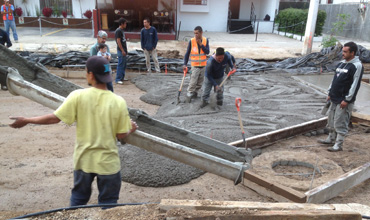
You've worked with numerous varieties of ready-mix concrete in the UK throughout the years, but you don't know how to maintain its durability. The following techniques will allow your pour to linger as long as possible. These are all tactics and practices that West London Concrete has learned over the years. As a result, we can offer some of the finest pours currently available on the market.
• Adequate Slab Thickness
When preparing to pour ready mix concrete, it can be difficult to determine the desired thickness. Although professionals can assist you in making this decision, you must ultimately decide on your own. Therefore, you must ensure that you thoroughly understand this issue to guarantee that everything runs properly. Fortunately, this problem has a rather straightforward solution: four inches is sufficient in most circumstances.
Depending on the nature of your driveway or parking lot, areas may require a thickness greater than four inches. For instance, you should be able to get away with a four-inch depth in most driveways, but you may need to modify your strategy if a high-traffic region wears down more quickly. So, add an extra inch to these spots to protect your driveway or parking lot.
Are there slimmer options than four inches? You are probably placing too much pressure on the surface at that point. Even though it should spread pretty evenly and limit damage to most locations, not taking the time to add at least four inches can cost you more money in the long run because it will increase the strain on your pour. Therefore, it is prudent to strive for a thickness of four inches or more, especially if you want your slab to endure longer or resist wear and tear better.
• Proper Healing Procedures
Curing is necessary to ensure that your pour is as secure as possible. This phase may appear straightforward; after all, you wait for the ready-mix concrete to dry. However, you must follow the correct procedures to ensure everything goes successfully.
For instance, you must maintain the surface warm and moist for as long as possible to ensure that it is as durable as feasible. You do not need to water the driveway, but you should apply a liquid membrane to the slab's surface after it is complete. This step helps to prevent excessive drying and ensures that the surface cures at a sensible rate.
Try to pour cement only during the warmer months, when freezing is least prone to occur. Unfortunately, freezing conditions can hinder the curing process and cause slabs to deteriorate prematurely, which can be difficult to restore. Consequently, it is vital to monitor the weather and to only operate with cement when temperatures are optimal; this should help prevent significant damage.
• Proper Winter Management
Knowing how to care for concrete throughout its first winter is essential. People do not always comprehend that winter is frequently the most difficult season for cement. Cold weather can cause the surface to expand and compress in unsettling ways. To minimise complications, it is vital to manage this scenario as easily as possible.
For instance, salt and other chemical deicers should not be used on your driveway. Utilising them too soon may cause the cement to expand and shrink, resulting in significant damage. In addition, you must avoid salt, specifically by washing it off your vehicles and driveway if you track it in from other roadways. Unfortunately, the potential influence on your driveway is that significant.
Fortunately, ice may be avoided simply by replacing cement with sand. Sand is preferable to salt since it does not create the same level of destruction. In addition, it does not induce melting as rapidly, reducing your damage potential. Even years later, NEVER use fertiliser as a deicer on a cement driveway since it is far too acidic and harmful.
Reach Out to Us for More Assistance